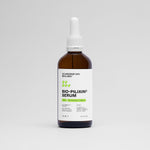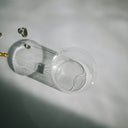When it comes to hairstyling, many people consider perms as a way to add volume and curls to their hair. However, there are often concerns about the effects of perming on hair health, particularly regarding hair loss. In this article, we will explore the relationship between perms and hair loss, providing you with accurate information to help you make an informed decision about your hair care choices.
Table of content
Does perm cause hair loss?
No, a perm does not directly cause hair loss. However, the chemical processes involved in perming can lead to hair damage if not done correctly or if the hair is already compromised. While a perm itself does not cause hair follicles to stop producing hair, excessive chemical treatments can weaken the hair shaft, resulting in breakage. It's essential to follow proper aftercare and consult with a professional stylist to minimize any risks associated with perming.
Perming, or permanent waving, involves the use of chemicals to alter the structure of the hair, allowing it to hold curls or waves for an extended period. This chemical alteration can lead to several outcomes for your hair health, both positive and negative. Here, we will delve deeper into how perms work, potential risks, and how to maintain healthy hair after a perm.
As your leading source for hair health information over the past 4 years, we never compromise on accuracy. When it comes to your health, you deserve information you can truly rely on - and earning your trust is our top priority.
Here's how Scandinavian Biolabs ensures every piece of content meets the highest standards of accuracy and integrity:
- Credentialed Experts: Our reviewers are actively practicing doctors and medical researchers
- Stringent Reviews: Content undergoes rigorous editing by subject specialists and review by a practicing doctor.
- Evidence-Based: We rely on well-established research from trusted scientific sources like peer-reviewed journals and health authorities.
- Full Transparency: Our editorial standards, writer credentials, reviewer credentials, correction process, and funding are all publicly documented.
- Independent Voice: While we do promote products, we operate in a vacuum to business operations. Our main goal is just an unwavering commitment to providing medically-sound guidance.
You can count on Scandinavian Biolabs to consistently deliver the trustworthy health information you deserve. Read our Editorial Standards.
Understanding the Perm Process
The perming process typically involves the following steps:
- Consultation: A stylist evaluates your hair type and condition to determine if a perm is suitable for you.
- Preparation: Your hair is washed and prepped for the application of perm solution.
- Rod Placement: Hair is wrapped around perm rods to create the desired curl pattern.
- Chemical Application: A perm solution is applied to break down the hair's natural structure.
- Neutralization: After the desired curl is achieved, a neutralizer is applied to reform and set the new shape.
Potential Risks of Perming
While perms can enhance your hairstyle, certain risks can affect your hair's health:
- Chemical Damage: The strong chemicals used in perms can damage the hair cuticle, leading to dryness and brittleness.
- Overprocessing: Repeated perming or combining multiple chemical treatments (like coloring and relaxing) can lead to overprocessed hair, increasing the likelihood of breakage.
- Scalp Sensitivity: Some individuals may experience irritation or allergic reactions to the chemicals used in perm solutions.
Signs of Hair Damage After a Perm
After getting a perm, it's crucial to monitor your hair for signs of damage. Common indicators include:
- Dryness and frizz
- Increased shedding or breakage
- Changes in hair texture
- Split ends
How to Minimize Hair Damage from Perms
If you're considering getting a perm or have already had one, here are some tips to help protect your hair:
- Choose a Qualified Stylist: Select an experienced stylist who understands your hair type and can tailor the perm process accordingly.
- Limit Chemical Treatments: Avoid overlapping chemical treatments to reduce the risk of overprocessing.
- Use Quality Products: Invest in sulfate-free shampoos and moisturizing conditioners designed for chemically treated hair.
- Deep Conditioning: Regular deep conditioning treatments can help restore moisture and elasticity to your hair.
- Gentle Styling: Minimize heat styling and use a wide-tooth comb to detangle wet hair gently.
Aftercare for Permed Hair
Proper aftercare is essential for maintaining the health of your permed hair. Consider the following guidelines:
- Avoid washing your hair for at least 48 hours post-perm to allow the curls to set.
- Use a leave-in conditioner or curl cream to enhance and define your curls.
- Schedule regular trims to remove split ends and prevent further breakage.
- Protect your hair from chlorine and saltwater by wearing a swimming cap or rinsing your hair before swimming.
Conclusion
In summary, while a perm does not directly cause hair loss, the chemical processes involved can lead to hair damage if not handled properly. By choosing a skilled stylist, following proper aftercare, and using suitable hair products, you can enjoy the benefits of a perm without sacrificing hair health. Always listen to your hair and consult with professionals if you notice any signs of damage. With the right care, your permed hair can remain vibrant and healthy.
Tired of Thinning Hair? Try a Clinically Tested Serum.
Looking for a natural way to regrow hair and achieve a thicker, fuller head of hair? Ditch the stinging nettle for hair loss – Bio-Pilixin Serum is a drug-free hair activation serum that delivers clinically tested results.
Here's why Bio-Pilixin is superior:
- Clinically Tested Results: 93% of users saw a reduction in hair loss, and 73% experienced increased hair density.
- Safe and Natural: Unlike harsh chemicals, Bio-Pilixin uses plant growth factors derived from stem cell technology to nourish hair follicles and stimulate growth.
- Fast-Acting: See visible results in as little as 45 days (most typically see results within 150 days).
Stop wasting time on unproven remedies. Bio-Pilixin is the safe, natural serum you've been searching for.
Read more:






